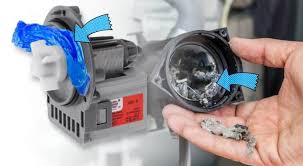
How To Unclog a Washing Machine Drain
Share
Image credit: Coimbatore Service
Is your washing machine failing to drain properly? Don’t worry—it’s a common issue with several easy fixes. Rather than calling a repair technician, you can often tackle the problem yourself with some basic tools and a little guidance. This article will walk you through unclogging a washing machine drain. And, if you need any replacement parts, PRS Parts Inc., a local Hawaiian company, offers a variety of washing machine parts, including drains. Additionally, PRS Appliances sells new but heavily discounted, second-channel appliances, so if you’re considering a replacement, you can find great deals locally.
1. Signs Your Washing Machine Drain is Clogged
Before starting, ensure the issue is actually a clog. Here are some common symptoms:
- Water pooling in the drum after a wash cycle
- Slow drainage or no drainage at all
- Unpleasant odors from the machine
- Strange noises or water spilling out when draining
2. Tools You’ll Need
Gather these tools to make the process easier:
- Bucket and towels
- Drain snake or wire hanger
- Pliers
- Screwdriver
- Replacement drain parts, if needed (available from PRS Parts Inc.)
3. Steps to Unclog a Washing Machine Drain
Step 1: Unplug the Machine
Before you start, unplug your washing machine to avoid any electrical hazards.
Step 2: Locate the Drain Hose and Drain Pump
Most washing machines have a drain hose and a pump filter at the bottom, accessible from the back or front lower panel. Unscrew the panel carefully with a screwdriver, if needed.
Step 3: Drain the Remaining Water
Place a bucket under the drain hose to catch leftover water, and keep towels nearby for spills. Use pliers to loosen the clamp holding the drain hose, then gently remove it from the machine’s drain pump.
Step 4: Inspect and Clean the Hose
Check for blockages in the hose—items like lint, coins, or even socks can easily get stuck inside. A drain snake or wire hanger can help dislodge any debris.
Step 5: Check the Drain Pump Filter
The pump filter is designed to catch foreign objects before they enter the drainage system. Open it carefully and remove any items, then clean the filter thoroughly before reinstalling it.
Step 6: Test the Drain
Once everything is cleaned and reassembled, run a short rinse cycle to check if the water drains correctly.
4. When to Replace the Drain
If you’re still having drainage issues, it may be time to replace a damaged drain hose or pump. PRS Parts Inc., a trusted local supplier, offers replacement washing machine drains and other parts so you can find what you need quickly without high shipping costs from the mainland. And if your machine is aging or in need of frequent repairs, PRS Appliances has an inventory of new, heavily discounted second-channel appliances available right here in Hawaii.
Tips for Preventing Future Clogs
- Use a mesh bag for small items like socks or delicates to prevent them from getting caught in the drain.
- Check pockets for coins, keys, and other small objects before loading clothes.
- Clean the drain pump filter every few months to prevent buildup.
Following these steps can often resolve drainage issues without professional help. And remember, whether you’re looking for replacement parts or a reliable appliance upgrade at a discount, PRS Parts Inc. and PRS Appliances are here to help, keeping Hawaiian households running smoothly!
Image source: Coimbatore Service
